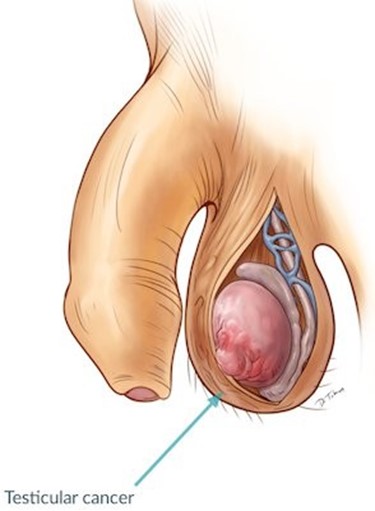A nurse is providing teaching for a client about testicular cancer. Which of the following manifestations should the nurse instruct the client to monitor for during self-examination?
A painless lump in the testicle.
Decreased size of the testicle.
Left testicle descending lower than right testicle.
Dilated veins above the testicle.
The Correct Answer is A
Choice A rationale:

Testicular cancer may present as a painless lump or swelling in the testicle. It's important for the client to monitor for any new or unusual lumps, as they could be indicative of cancer.
Choice B rationale:
A decreased size of the testicle is not a typical manifestation of testicular cancer. It is more commonly associated with conditions like testicular atrophy due to other causes.
Choice C rationale:
Asymmetry in the position of the testicles, with one testicle descending lower than the other, is a normal variation and not a sign of testicular cancer.
Choice D rationale:
Dilated veins above the testicle can be a sign of a varicocele, which is a separate condition from testicular cancer. It is caused by abnormal enlargement of veins in the scrotum and is generally not associated with cancer.
Nursing Test Bank
Naxlex Comprehensive Predictor Exams
Related Questions
Correct Answer is D
Explanation
Answer: D. A client whose medications to manage Parkinson's disease are no longer effective.
Rationale:
A) A client who is newly diagnosed with type 1 diabetes mellitus and cannot afford insulin:
While this client has a significant medical issue, the primary concern here is financial rather than palliative. Palliative care focuses on providing relief from symptoms and improving quality of life for those with serious illnesses. Addressing the client's financial issues might involve social services or community resources rather than palliative care.
B) A client who has Meniere's disease and cannot safely ambulate due to vertigo:
Meniere's disease, while debilitating, may not necessarily require palliative care unless the symptoms are severely impacting the client's quality of life in a way that is not manageable with current treatments. Palliative care could be considered if the disease is severely limiting function and other supportive care is needed.
C) A client who had a stroke and cannot eat or drink without choking:
This client is experiencing a significant functional impairment due to the stroke, which might benefit from rehabilitative services rather than palliative care. Palliative care would be more appropriate if the client's condition is progressive, severe, and not responsive to treatment, leading to a focus on comfort and quality of life.
D) A client whose medications to manage Parkinson's disease are no longer effective:
When medications for Parkinson's disease are no longer effective, the client may be experiencing advanced symptoms and a decline in quality of life. Palliative care can provide symptom management, support, and enhance the client's quality of life when conventional treatments are no longer effective in controlling symptoms.
Correct Answer is D
Explanation
Choice A rationale:
The nurse should not instruct the older adult client with osteoporosis to increase high-impact activities. Osteoporosis is a condition characterized by decreased bone density and strength, making high-impact activities potentially harmful as they could increase the risk of fractures.
Choice B rationale:
The nurse should not advise the client to consume a low-protein diet. Adequate protein intake is essential for maintaining muscle mass and overall musculoskeletal health, especially in older adults who may be at risk of muscle wasting.
Choice C rationale:
The nurse should not encourage the client to maintain a BMI of 30 to 35. A BMI within this range is considered obese and can put additional stress on the musculoskeletal system, increasing the risk of joint problems and other health issues.
Choice D rationale:
Including fiber in the diet is a correct instruction for promoting musculoskeletal health. Fiber-rich foods can help maintain bowel regularity and prevent constipation, which is important for overall comfort and mobility in older adults with osteoporosis.
Whether you are a student looking to ace your exams or a practicing nurse seeking to enhance your expertise , our nursing education contents will empower you with the confidence and competence to make a difference in the lives of patients and become a respected leader in the healthcare field.
Visit Naxlex, invest in your future and unlock endless possibilities with our unparalleled nursing education contents today
Report Wrong Answer on the Current Question
Do you disagree with the answer? If yes, what is your expected answer? Explain.
Kindly be descriptive with the issue you are facing.
